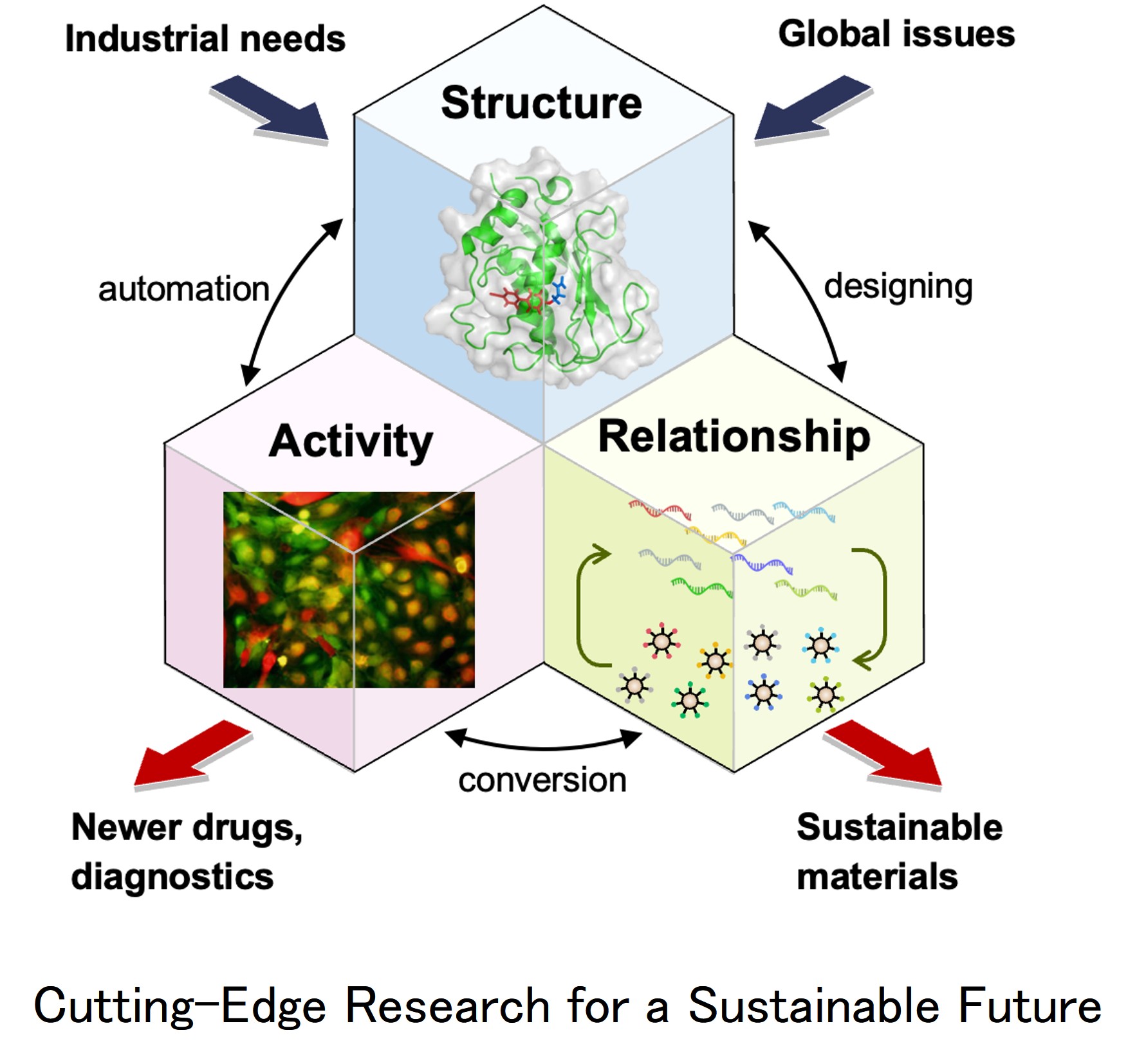Bio-Structure-Activity Relationship Research Group
Introduction
Bio-Structure-Activity Relationship (BioSAR)
"Structure-Activity Relationship (SAR)" refers to the approach of determining the relationship between the structure and activity of candidate molecules to develop drugs with superior properties. The concept is based on the idea that there is some "link (relationship)" between a molecule's "shape (structure)" and its "function (activity)," and uncovering this correlation is key to creating the desired molecules. The BioSAR group aims to harness the power of biology by analyzing and controlling the structures of biomolecules to create not only drugs but also highly functional biomolecules. Positioned at the intersection of biophysics, biochemistry, and molecular biology, a team of researchers with diverse expertise is working to develop technologies that address these challenges. Through the development of the following three foundational technologies, we are advancing the creation of a technological platform for producing innovative molecules.

1. Structural Analysis
Structural analysis is an indispensable technique for the rational design of biomolecules. Understanding protein-ligand interactions is particularly crucial in drug discovery. Using X-ray crystallography, we can determine the three-dimensional structure of molecules with high precision. We have systematically established a workflow that spans from gene construction to protein purification and crystallization screening. Recently, robotics automation and machine learning have been introduced to improve analysis efficiency, enabling rapid data collection and structural analysis. This technology allows us to gain a precise understanding of molecular interactions and recognition dynamics, thus advancing drug design efficiently. While simulations, such as alpha-fold, are also integrated, X-ray crystallography provides actual measured data, serving as a solid intellectual foundation. By combining these structural insights with bioactivity data, we aim to create new molecules that can address ligand molecule structure development and gene mutations.
2. Bioactivity Evaluation
While designing ligand candidate molecules and gene mutations based on structural information is important, it does not guarantee that they will function as expected in vivo. To explore promising drug candidates from a vast library of potential molecules (ranging from 100 to 10,000 types), it is necessary to construct a high-throughput screening (HTS) experimental system. The HTS system includes enzymatic assays using classical biochemistry and cell-based assays that measure responses from cells. As an effective method for constructing cell-based evaluation systems, we create model cells targeting specific genes using genome editing, allowing for precise evaluation of responses within the cells. We have also succeeded in visualizing miRNA expression in cells using reporter genes (e.g., fluorescent proteins or luciferase). Additionally, we handle a variety of model organisms, including microorganisms, animal cell cultures, and plant cell cultures, and are working on cross-platform evaluation technology development to meet a wide range of industrial needs.
3. Evolutionary Molecular Engineering
To further optimize gene sequences that can be utilized as biopharmaceuticals, we employ evolutionary molecular engineering. To obtain gene sequences that perform the desired function, it is necessary to convert phenotypes into genotypes, and evolutionary molecular engineering enables the exploration of optimal biomolecules. We perform a cycle of "mutation," which generates various sequences, "selection," which identifies molecules with enhanced functionality, and "amplification," which repeats in a test tube. Through this process, we have created new DNA aptamers and functional RNAs (e.g., ribozymes). We have also developed an "accelerated evolution system" that automatically introduces mutations only into the target gene, and by selecting and culturing cells that express highly active molecules, the gene sequence is optimized. Using ultra-parallel screening techniques (e.g., CRISPR screening), we mimic biological processes to exceed natural biological functions in "bio-manufacturing."

To address global challenges such as resource depletion, environmental pollution, and population issues, transitioning to a circular society that no longer relies on fossil fuels or chemicals is essential. Achieving this requires leveraging the unique properties of biology—such as energy conversion efficiency, environmental compatibility, and specific interactions—and integrating them into industry. Our group is committed to developing state-of-the-art biotechnologies and pioneering new frontiers of knowledge through academic challenges. Specifically, we aim to drive pioneering research in areas such as novel drugs for infectious diseases, pesticides, countermeasures against antibiotic-resistant bacteria, and sustainable biomaterials, with the goal of becoming a driving force for societal transformation.
List of Publications
Staff:
- Yoshio Kato(Research Group Leader)
- Kazuhiko Yamasaki
- Tomomi Kubota
- Daijiro Takeshita
- Yuuichi Furuhata
- Yuko Takagi
- Takashi Nishio
- Nanami Nishijima